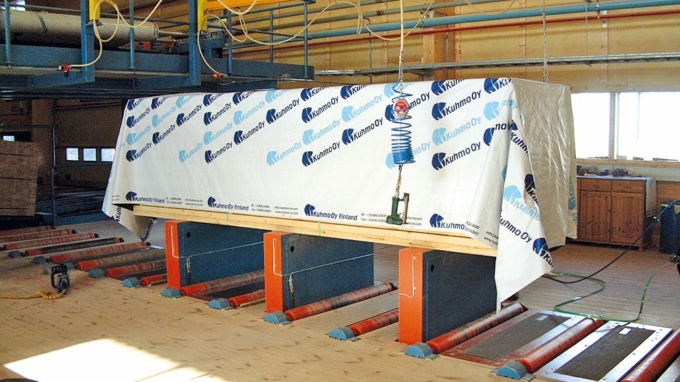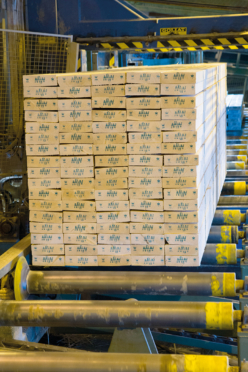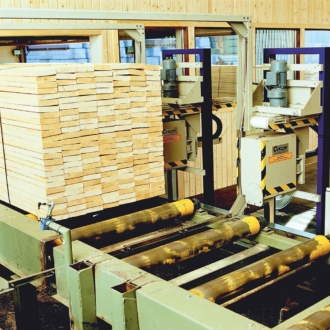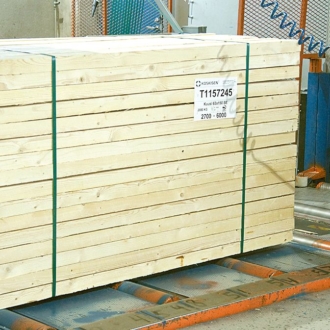The packaging process starts when the conveyor moves the sorted pieces of sawn timber from the sorting department to the timber hoist of the packaging department.
Equipment
Hoist
One of the most common type is a chain hoist. The top and bottom ends and the pocket in the middle are equipped with chain wheels. The conveyor chains of the timber hoist run around these wheels.
The rakes of the conveyors are designed to lift one piece of sawn timber at time. The extra pieces will drop down to the beginning of the lift hoist. The pieces of sawn timber rise to the feed table of the packaging department as a flat flow.
The chain hoist lifts the pieces of sawn timber on roller conveyor. The transverse roller conveyor moves the pieces of sawn timber so that the butt ends are on the same level. At the same time, the chain conveyor moves the pieces forward to the feeding device. There is a short, gravitational conveyor on which the pieces of sawn timber move as they head towards the feeding device.
Feeding device
The speed of the feeding device must be synchronized with the speed of the packaging conveyor. Today the speed can be very high, but there is always only one piece in between the rakes. The packaging conveyor moves the pieces of sawn timber again on the transverse rollers. Before these rollers, the stamping of the bottom end of the pieces takes place.
The rollers are again installed in such a way that they are a little bit above the chain conveyor. The speed of the rollers is synchronized with the speed of the chain conveyor and the rollers are also slightly inclined compared to the chain conveyor. When the speeds are right and the rollers inclined enough the pieces of sawn timber will move over the packaging table without hitting the rakes of the chain conveyor. Next the stamping of the top end of sawn timber takes place.
Applicator
The layers for the sawn timber package will be formed at the end of the packaging conveyor. After the packaging conveyor there is another conveyor, with a lower speed. This is how the packaging conveyor can feed the pieces of sawn timber tightly side by side. The width of the sawn timber package is as close to one metre as possible. The number of pieces for one layer depends on the width of the piece of sawn timber.
When there are enough pieces for one layer, the applicator lifts up the entire layer above the conveyor and moves it to the packet elevator. This phase is critical for the tightness and appearance of the package.
The movement of the applicator must be synchronized to the speed of packaging line and depending on the dimension of sawn timber the speed may be very high. The acceleration and deceleration of the applicator must be very soft to keep the layer flat. Especially the control of thinnest dimensions is very delicate to keep the movement under control.
Truck package and length sorted package
When the applicator is on the package, it puts the layer down on the packet and moves it back to be ready for the next layer. At this phase, there may be some problematic accumulation of pieces. Especially when packaging so-called falling lengths, with several different lengths of sawn timber, the accumulation or crisscrossing is possible. The packages consisting of different lengths are called truck packages.
The control of length sorted packages, with all pieces of the same length, is easier. When the layer is ready, the packet lift moves down one layer.
Spacers
The height of the sawn timber package is about one meter. In order to keep the package in the right shape there must be wooden spacers/laths between the specified layers of the packet. These spacers are dropped from above onto the packet layers.
Normally there are spacers on two layers of the package, but especially when packing narrow dimensions, it can be necessary to use spacers on more than two layers.
When the timber package is on the lift, it is also possible to set protective paper on it. Usually, when the second to last layer is ready the paper applicator pulls and cuts from a roll a sheet over the timber package. Such papering protects the package only partially and is not suitable for storage in the open.
The timber package goes to a packing press, where the package is compressed to a regular sized unit. The size of the package is approximately 1m x 1m. Thin spacers are used between specified layers and the packages are strapped tight with straps to keep the package in shape during different processing phases. The packages are mostly protected with protection wrap or hood from three or five sides. © Metsä Group/Studio Tomi Aho
Strapping
Often the strapping conveyor has been installed a few degrees sloping to keep the unstrapped package firm in shape. The conveyor moves the package to the strapping press which is also installed in a slope at the same angle as the conveyor.
Depending on the production capacity of the sawmill, there are normally one or two strapping presses. Most often the package is strapped with 3 to 5 straps.
The control logic of the strapping press gets the information to start the compression and strapping process from the control logic of the conveyor.
- When the conveyor control logic gives the start information, the upper compression bar moves down on the package without compressing the package at this point.
- Finally, the compression bar on the side moves against the package and compresses the package from the side with a predetermined force.
Typically, the strapping presses are hydraulic and the compression force is adjusted by the pressure limit switch. When the adjusted compression force is reached, the side bar stops and moves slightly backwards to let the upper bar compress the package from above to an adjusted compression force. The pressure limit switch of the upper bar then starts the strapping process.
- The strapping head feeds the strap around the packet through the strap chute
- The strap comes back to the strapping head and will be firmly attached by the strap end clamps.
- The strapping head pulls the strap around the timber package and makes the final tensioning to the pre-set tension parameter before sealing and cutting the strap.
In the past only steel straps were in use but today a PET-strap, which is made of polyester, is used almost exclusively.
The steel strap is mainly sealed without separate seals, but separate seals are sometimes used. The PET-strap is sealed by friction or iron welding.
When the strapping is ready, the press bars move back to the base position and the conveyor moves the timber package forward. The strapping process is repeated by the strapping presses so often that the pre-set number of straps is ready. The amount of straps depends on the length of the timber package.
The strapping systems in Finland are supplied among others Cyklop, Fromm Pakkaus and Signode.
Protection
After the strapping, the package moves on the hydraulically tiltable roller conveyor that lowers the package horizontally. The next roller conveyor moves the package to protection and labelling.
The package can be protected by protective paper or plastic pulled from the roll, or by a protective hood. When using a protective wrap pulled from the roll, the package moves under the wrap applicator. The photocell starts the feeding of the wrap from the wrap roll and the wrap drops over the timber package. At the end of the package, conveyor stops and the cutting blade of the wrap applicator cuts the protection wrap to right length. The protection wrap can also be cut manually with a knife.
The pull of the protection wrap on the package can also be done manually from a roll on the rack. The operator spreads the protective wrap over the package and then folds the wrap tidily. Often the wrap is fastened with a stapler and plastic staples. The wrap can also cover the side of the packet but there are in use also narrower wrappings, which cover for instance half of the side of the package.

A robotic solution has been developed to apply a hood over the timber package. The packaging line can also be equipped with a weighing scale.
Plastic hoods are made to a certain length, often printed with a company logo and company information. These kinds of hoods are used to protect length sorted, mostly higher-grade sawn timber. The hood can protect the timber package from five sides, except the bottom side of the package, under the hood.
At the same time when the package is protected, the package labels are also attached. Often the next equipment on the line is a strapping machine, which straps the protection wrap or the hood on the packet. The principle of the operation of this machine is similar with timber strapping, but without compression. The protection wrap or hood can also be stapled on the package with pads and plastic staples.
After the last strapping, the package moves to the exit conveyor which usually is a chain conveyor.




